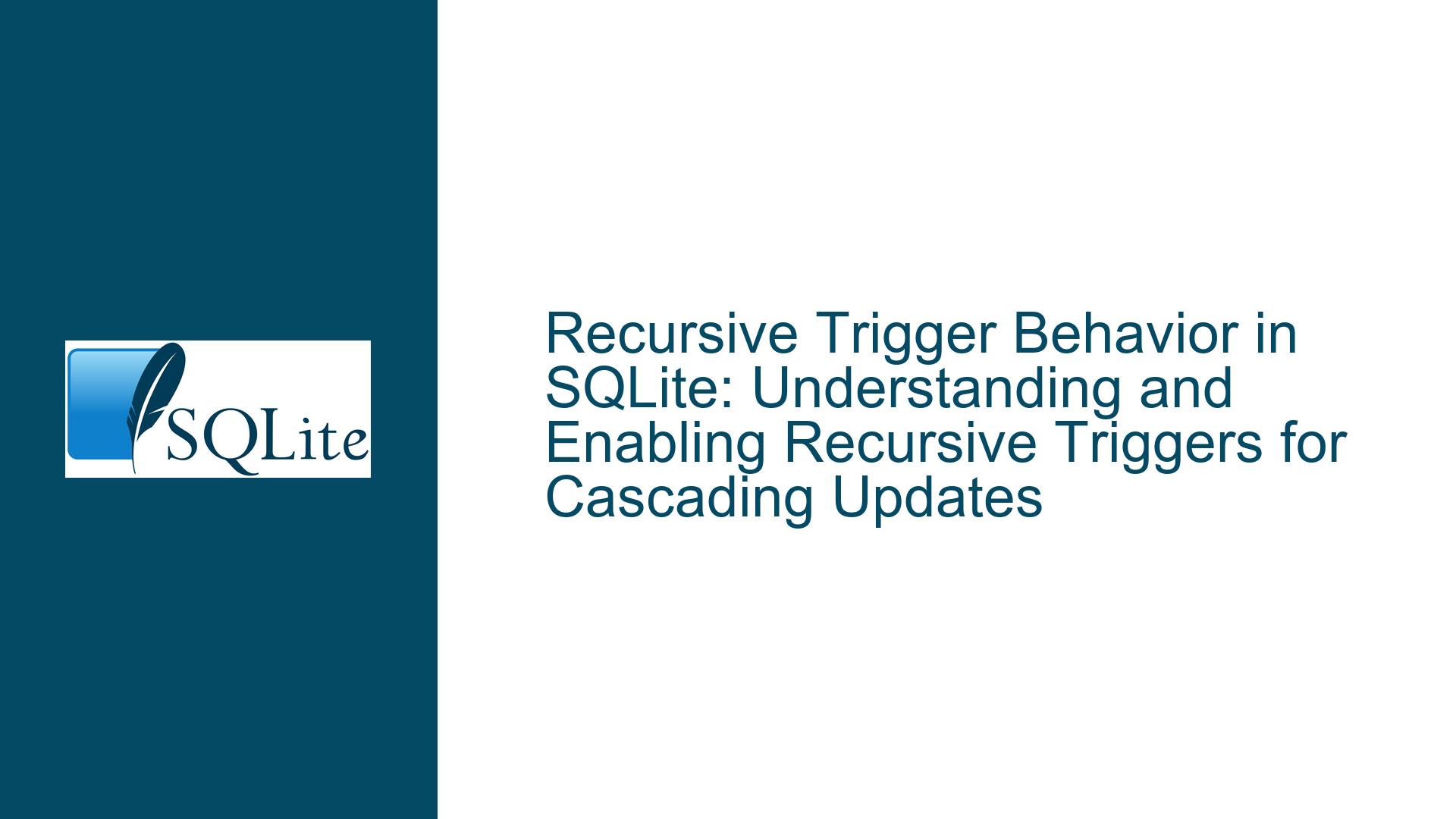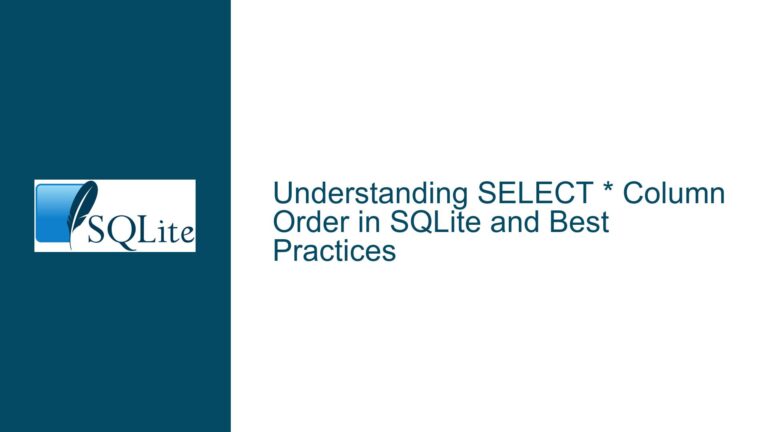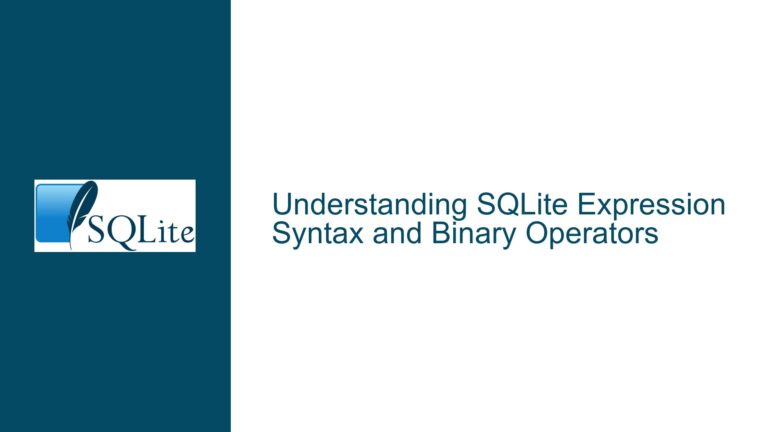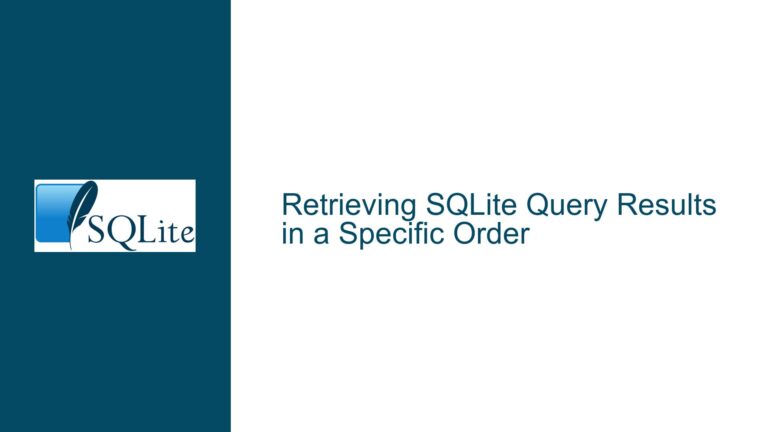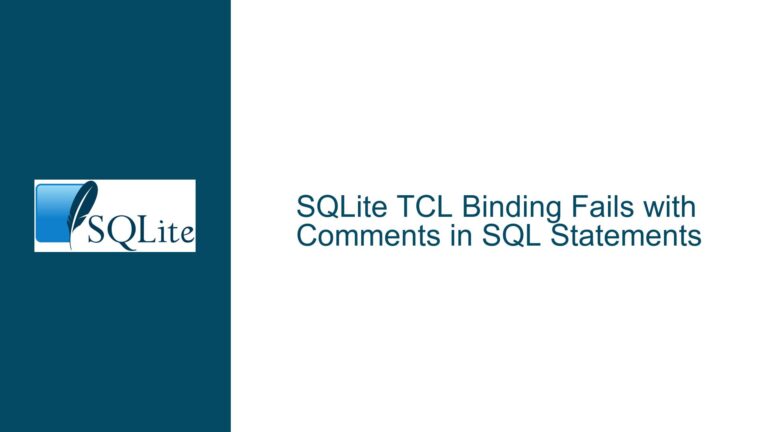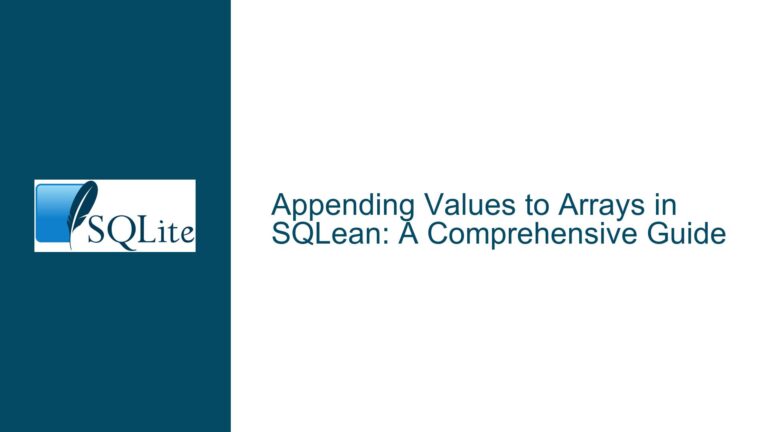Recursive Trigger Behavior in SQLite: Understanding and Enabling Recursive Triggers for Cascading Updates
Recursive Trigger Chain Halts on Self-Referential Table Updates
When working with SQLite triggers, particularly in scenarios involving cascading updates across a tree-like data structure, developers often encounter a situation where a trigger chain stops prematurely. This issue arises when an AFTER UPDATE trigger on a table attempts to update another row within the same table, expecting the change to propagate recursively. However, without explicit configuration, SQLite does not allow triggers to fire recursively by default. This behavior can be particularly confusing when the trigger logic appears correct, but the expected cascading updates do not occur.
For example, consider a table a with a self-referential relationship, where rows reference other rows in the same table via a fromA column. An AFTER UPDATE trigger is created to propagate changes to the sharedProp column from a parent row to all its descendant rows. When an update is performed on a parent row, the trigger should update all related rows in the same table, as well as rows in a related table b. However, without enabling recursive triggers, the trigger chain halts after the first update to the same table, leaving descendant rows unchanged.
This behavior is not a bug but a deliberate design choice in SQLite to prevent infinite loops and unintended side effects. Recursive triggers must be explicitly enabled to allow such cascading updates to propagate fully. Understanding this behavior and how to configure SQLite to support recursive triggers is crucial for implementing complex data propagation logic.
Recursive Triggers Disabled by Default in SQLite
The root cause of the issue lies in SQLite’s default configuration, which disables recursive triggers. Recursive triggers are a powerful feature that allows a trigger to fire as a result of changes made by another trigger, including changes to the same table. However, enabling this feature requires either compiling SQLite with the SQLITE_DEFAULT_RECURSIVE_TRIGGERS flag set to 1 or using the PRAGMA recursive_triggers statement to enable recursive triggers at runtime.
By default, SQLite is compiled with SQLITE_DEFAULT_RECURSIVE_TRIGGERS set to 0, meaning recursive triggers are disabled unless explicitly enabled. This default setting prevents triggers from firing recursively, which can lead to unexpected behavior when designing cascading updates or other complex trigger logic. In the example provided, the trigger on table a attempts to update other rows in the same table, but the trigger chain stops because recursive triggers are not enabled.
Additionally, the use of incorrect string delimiters in SQL statements, such as double quotes for text strings instead of single quotes, can lead to subtle issues. While this does not directly affect the recursive trigger behavior, it is a best practice to use single quotes for string literals and double quotes for identifiers to avoid potential parsing errors or unintended behavior.
Enabling Recursive Triggers and Validating Cascading Updates
To resolve the issue and enable recursive triggers, you must explicitly enable them using the PRAGMA recursive_triggers statement. This can be done at the beginning of your session or within your application code before executing any queries that rely on recursive trigger behavior. The following steps outline how to enable recursive triggers and validate the cascading update logic:
Enable Recursive Triggers: Execute the
PRAGMA recursive_triggers = 1;statement at the start of your session or application. This ensures that triggers can fire recursively, allowing changes made by one trigger to trigger additional updates.Verify Trigger Logic: Ensure that your trigger logic is correctly defined to propagate changes as intended. For example, the trigger on table
ashould update both the same table and related tables likebto ensure all dependent rows are updated.Test Cascading Updates: Perform an update on a parent row and verify that the changes propagate to all descendant rows in the same table and related tables. Use
SELECTstatements to confirm that thesharedPropcolumn is updated as expected.Use Proper String Delimiters: Ensure that all string literals in your SQL statements are enclosed in single quotes, and identifiers are enclosed in double quotes. This avoids potential parsing issues and adheres to SQL standards.
Here is an example of how to implement and test the solution:
-- Enable recursive triggers
PRAGMA recursive_triggers = 1;
-- Create the tables
CREATE TABLE a(
id INTEGER,
fromA INTEGER,
sharedProp TEXT
);
CREATE TABLE b(
id INTEGER,
fromA INTEGER,
sharedProp TEXT
);
-- Create the trigger to propagate updates
CREATE TRIGGER a_sharedProp_updated AFTER UPDATE ON a
BEGIN
UPDATE a SET sharedProp = NEW.sharedProp WHERE fromA = NEW.id;
UPDATE b SET sharedProp = NEW.sharedProp WHERE fromA = NEW.id;
END;
-- Insert sample data
INSERT INTO a VALUES (1, NULL, 'foo'), (2, 1, 'foo');
INSERT INTO b VALUES (1, 2, 'foo');
-- Perform an update and verify the results
UPDATE a SET sharedProp = 'bar' WHERE id = 1;
SELECT sharedProp FROM b; -- Should return 'bar'
By following these steps, you can ensure that recursive triggers are enabled and that your cascading update logic works as intended. This approach allows you to propagate changes across a tree-like structure efficiently and reliably, avoiding the pitfalls of SQLite’s default configuration.
In conclusion, understanding SQLite’s behavior regarding recursive triggers and knowing how to enable them is essential for implementing complex data propagation logic. By enabling recursive triggers and validating your trigger logic, you can achieve the desired cascading updates and ensure data consistency across your database.
